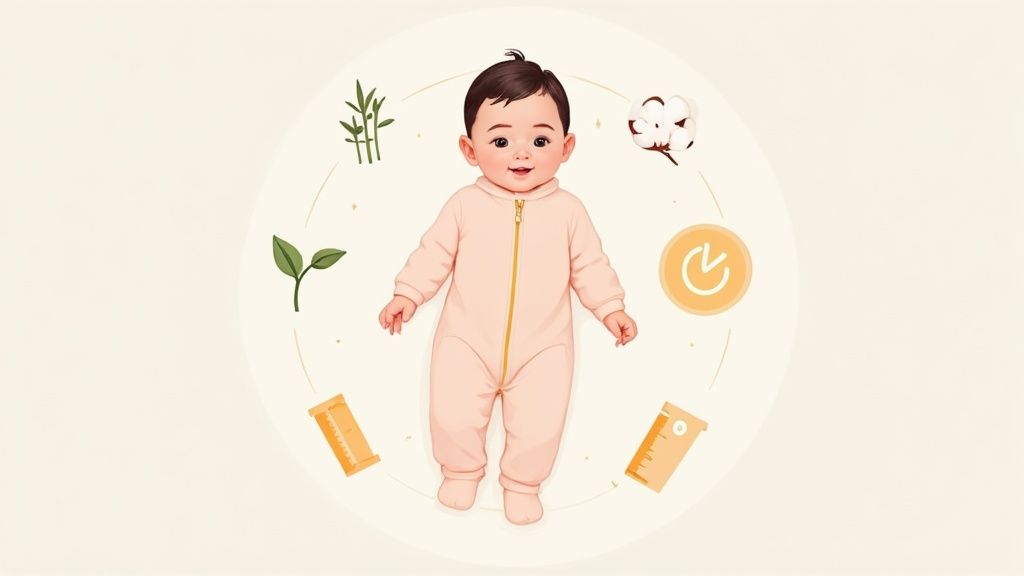
A Parent’s Guide to Baby Zipper Sleepers
Share
If you've ever fumbled with tiny snaps on a squirmy baby at 3 AM, you know the struggle is real. Baby zipper sleepers are the answer to every sleep-deprived parent's prayers. These one-piece wonders swap out those maddeningly difficult snaps for one simple, smooth zipper, making diaper changes faster than you can say "back to bed."
The best ones even come with a two-way zipper. This genius feature lets you zip up from the bottom, so you can change a diaper without completely undressing your baby and exposing their little chest to the cold. It's all about keeping them warm, cozy, and sleepy.
Why Parents Are Ditching Snaps for Zippers
Let's be honest, those middle-of-the-night diaper changes are tough. You're exhausted, it's dark, and the last thing you want to do is wrestle with a dozen snaps. This is exactly why zipper sleepers have become an absolute essential for so many families—they trade that late-night frustration for a little bit of sanity.
Think of this guide as your complete playbook for finding the perfect PJs. The kind that brings you peace of mind and, just maybe, a few more precious minutes of sleep.
The Real-World Difference
At its core, the biggest advantage is pure convenience. It’s the difference between trying to match up ten separate snaps on a wiggling infant and just pulling a single zipper. The amount of time and mental energy you save is no small thing when you're running on fumes.
The goal isn't just to dress your baby; it's to minimize disruption. A fast, quiet change means your little one is more likely to drift back to sleep quickly, and so are you.
This simple design change has a huge ripple effect. Suddenly, your routine feels a little less chaotic.
- Faster Changes: What might take a full minute with snaps can be done in seconds with a zipper.
- Less Fuss: Keeping your baby's upper body warm and covered during a change often means a calmer, happier baby.
- Easier Dressing: No more realizing you missed a snap and have to start all over again in the dark.
- Secure Fit: A zipper creates a solid, continuous closure that keeps drafts out and the sleeper comfortably in place.
We’re going to cover everything that actually matters, from those game-changing two-way zippers to the softest, safest fabrics for delicate skin. When you understand the full range of sleeper outfits for babies, you can pick something that truly works for your family. It's so much more than just baby clothes; it's a tool to help you navigate the beautiful chaos of parenthood.
How Zippers Reinvented Baby Pajamas
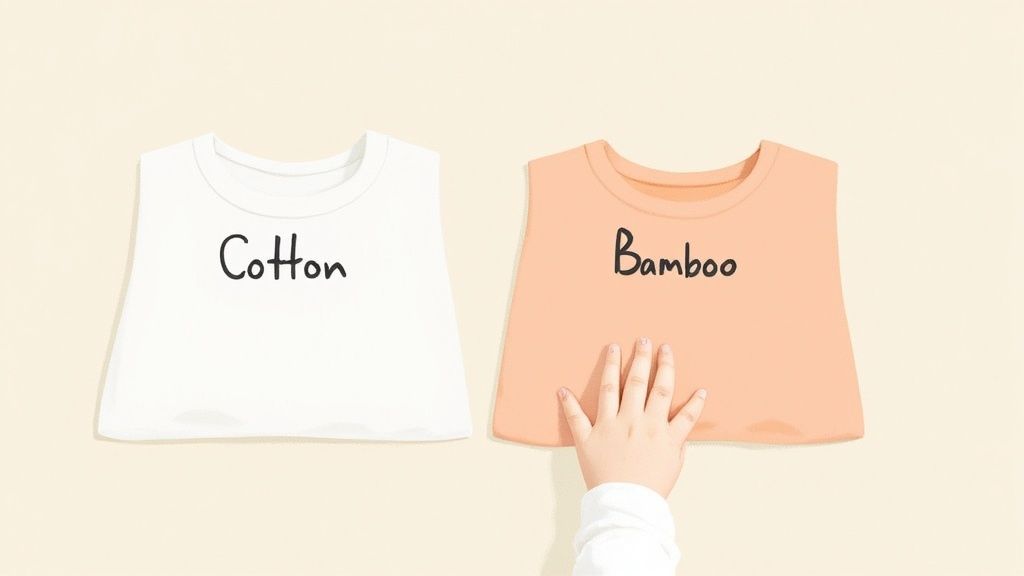
To really get why zipper sleepers are such a big deal, imagine you're fumbling with a remote that has twenty tiny, identical buttons in the dark. Now, picture swapping it for one with a single, simple slider. That's the difference between snaps and zippers.
Snaps are a pain. You’re trying to line up a dozen little closures, often in a dim room, with a squirming baby. It’s a recipe for frustration.
The zipper just makes sense. It turns dressing and undressing into one smooth move, getting rid of the guesswork and hassle. This one little change can turn a stressful nighttime chore into a quiet, quick moment.
The Two-Way Zipper Is a Game Changer
While any zipper beats snaps, the real hero here is the two-way zipper (sometimes called an inverted zipper). This is the feature that makes modern baby sleepers so incredibly practical.
A regular zipper only zips from the top down. But a two-way zipper can also unzip from the bottom up, and that small change makes a world of difference during those 3 AM diaper changes.
With a two-way zipper, you can open just the bottom of the sleeper to change a diaper. Your baby’s chest, arms, and tummy stay warm and covered, which means less fussing and a better chance they’ll drift right back to sleep.
This feature is so popular it has practically created its own market. In fact, sales for two-way zipper pajamas for babies now hit $1.42 billion globally every year. Parents are more than willing to invest in a design that makes life just a little bit easier. You can dig into the numbers in this market report on baby pajamas.
Small Details That Make a Big Difference
Beyond the zipper itself, the best sleepers include a few thoughtful details designed for safety and comfort. These are the little things that protect your baby’s delicate skin and give you peace of mind.
When you're shopping, keep an eye out for these features:
- Zipper Guard: This is a little fabric flap right at the neckline that covers the zipper pull. It’s a must-have to prevent the metal or plastic from poking your baby’s sensitive chin.
- Fabric Backing: Look for a strip of fabric running along the inside of the zipper. This genius addition ensures the zipper never touches your baby’s skin, so there’s no chance of pinching or chafing.
- Secure Stitching: A well-made sleeper will have the zipper sewn in tightly, with no loose threads or small parts that could become a hazard.
These details show that a brand cares about more than just convenience—they care about your baby’s safety and comfort. It's the combination of the smart zipper design and these protective elements that makes for truly great sleepwear for both you and your little one.
Choosing the Right Fabric for Your Baby
The fabric of your baby's sleeper is what they feel against their delicate skin all night long. Think of it as their first layer of comfort—a soft, protective hug that needs to be just right. Picking the right material isn't just about softness, though; it’s about how well it breathes, regulates temperature, and holds up after countless washes.
Some fabrics are perfect for keeping a baby warm and toasty on a chilly night, while others are designed to wick away sweat and keep them cool when it's warm. When you understand what each material does best, you can create the perfect sleep environment to keep your baby comfortable and happy.
Comparing Popular Sleeper Fabrics
You'll notice that baby zipper sleepers come in all sorts of fabrics, and each one has its own special perks. From silky-soft bamboo to ever-reliable cotton, knowing the difference will help you pick the best one for your little one and your climate.
Let's break down the most common options you'll see:
- Bamboo Viscose: Parents love bamboo for its unbelievable softness and amazing stretch. It's also naturally hypoallergenic and helps regulate body temperature, which is a huge plus for babies with sensitive skin or eczema.
- Organic Cotton: You can never go wrong with classic cotton. It's tough, breathable, and seems to get even softer the more you wash it. It's a great chemical-free choice that lets air flow freely, helping prevent your baby from getting too hot.
- Fleece: When the temperature really drops, fleece is your best friend. This synthetic material is incredibly warm and insulating, perfect for keeping your baby snug as a bug on those cold winter nights.
- Modal: A lot like bamboo, modal is a plant-based fabric known for its silky texture and how nicely it hangs. It's super absorbent and does a great job resisting shrinking and pilling, so it stays feeling new for longer.
If you're curious to learn more, you can check out all the bamboo fabric benefits for babies to see why it's become such a go-to for kids' clothing.
To help you decide, here’s a quick comparison of the most common materials used for baby sleepers.
Comparing Common Sleeper Materials
| Material | Best For | Breathability | Softness | Care |
|---|---|---|---|---|
| Bamboo Viscose | Sensitive skin, year-round use | Excellent | Buttery-soft | Gentle cycle, low heat |
| Organic Cotton | Everyday wear, warm climates | High | Gets softer with wash | Machine wash & dry |
| Fleece | Cold winter nights | Low | Very cozy & plush | Machine wash & dry |
| Modal | Luxurious feel, durability | Good | Silky-smooth | Gentle cycle, low heat |
Choosing the right fabric can honestly make a huge difference in how well your baby sleeps. It's all about finding that perfect balance of comfort, breathability, and warmth.
This infographic shows just how much faster zippers are compared to snaps, not to mention the frustration they save you from.
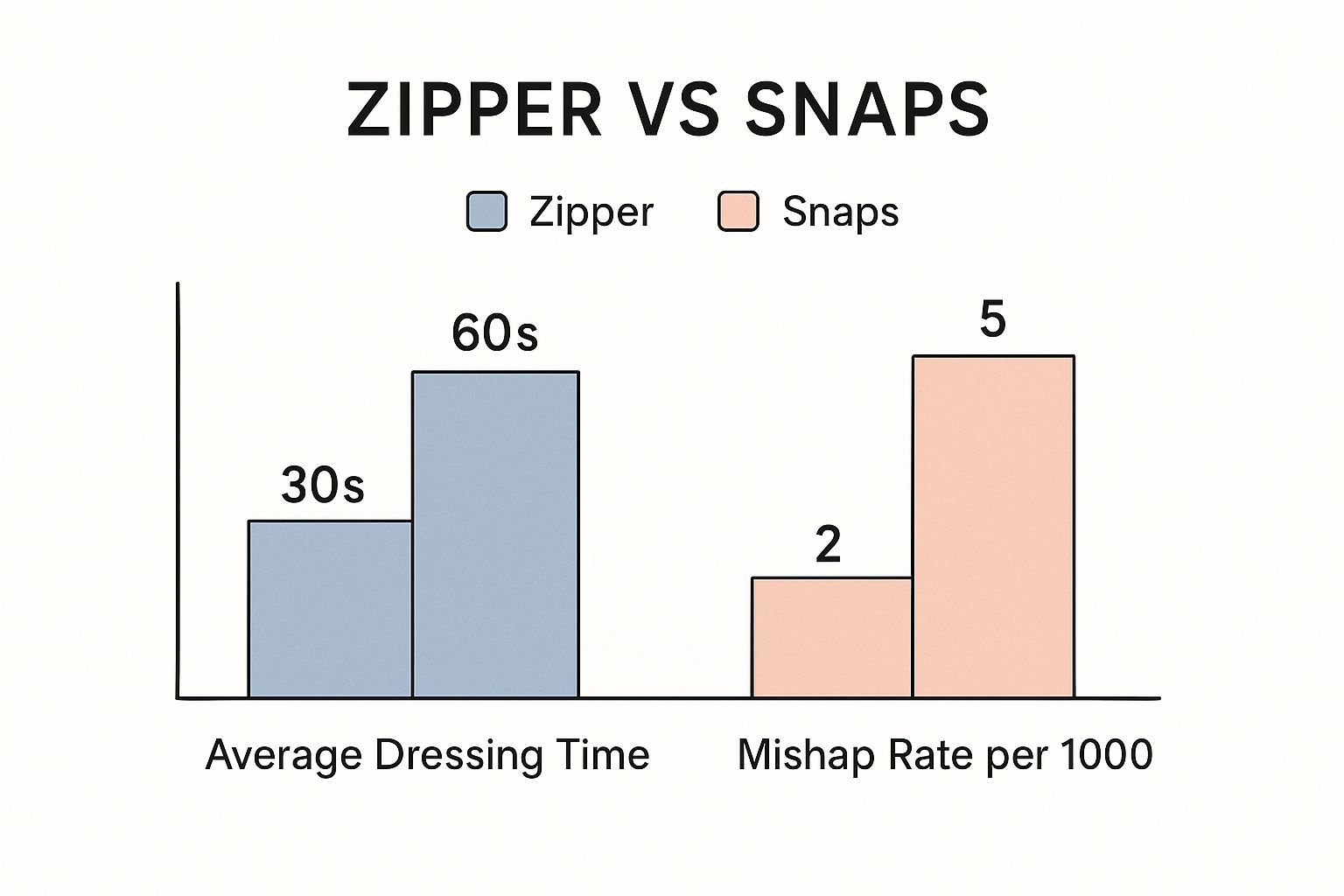
As you can see, zippers don't just speed things up; they also pretty much eliminate the chance of those annoying mismatched snaps in the middle of the night.
Making the Right Choice for Every Season
It’s so important to match the sleeper fabric to the season. Putting your baby in a fleece sleeper on a warm summer night is a surefire way to get a sweaty, fussy baby. On the other hand, a lightweight cotton sleeper probably won’t cut it during a January cold snap.
Think of it like dressing yourself for the weather. You wouldn't wear a wool sweater on a hot summer day, and the same logic applies to your baby’s sleepwear. Their comfort hinges on a material that helps them maintain a stable body temperature.
A good strategy is to have a few different types of sleepers ready to go. Keep some cozy fleece ones for the coldest months and have lightweight bamboo or cotton sleepers for warmer weather. For those in-between seasons like spring and fall, bamboo is a fantastic all-rounder because it naturally adapts to your baby's temperature.
Understanding Sleepwear Safety Standards
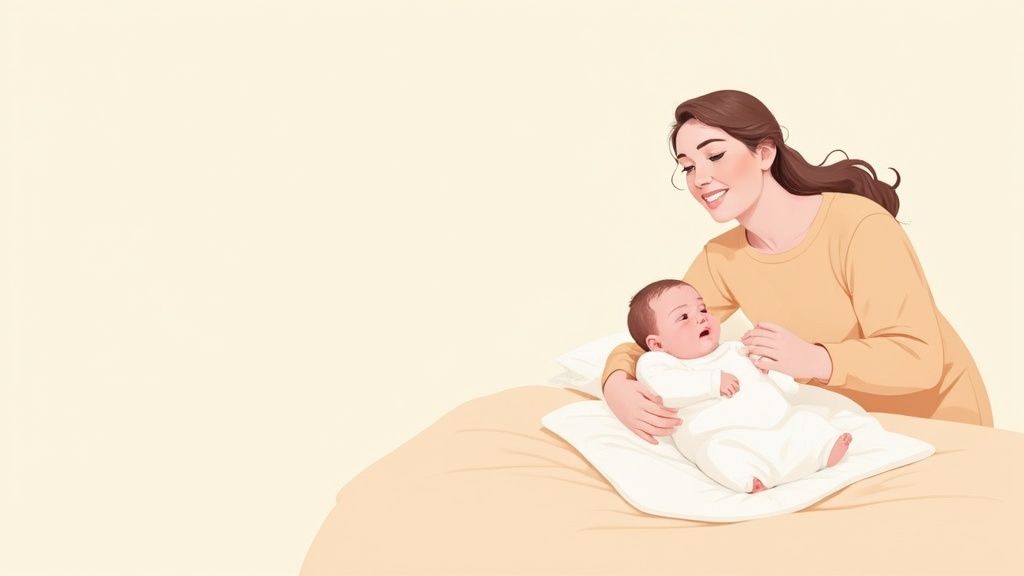
While the cute patterns and soft fabrics are what catch your eye, nothing trumps safety when it comes to your baby. Digging through sleepwear standards can feel like a chore, but it really boils down to a few key things that will give you total peace of mind.
It all starts with the fit. You’ve probably heard pediatricians and seasoned parents alike preach the importance of "snug-fitting" pajamas, and it’s not just for looks. This is a critical safety rule. Loose, baggy sleepwear can become a suffocation hazard if the fabric bunches up around your baby’s face in the crib. A snug fit means no extra material to get tangled in, plain and simple.
This is exactly why you see those specific tags on baby PJs—they’re there to tell you how the sleeper is designed to keep your little one safe.
Decoding Safety Labels
When you're shopping, think of the tags on baby clothes as your cheat sheet. They hold vital safety info, regulated by groups like the U.S. Consumer Product Safety Commission (CPSC), that helps you make the best choice.
Here’s what to keep an eye out for:
- CPSC Compliance: This is non-negotiable. Any brand worth its salt will meet CPSC guidelines, which means the clothing has passed federal safety tests for things like choking hazards (small parts) and fabric flammability.
- Flame Resistance: By law, sleepwear for babies over 9 months that isn't snug-fitting has to be flame-resistant. Honestly, most parents I know just opt for snug-fitting jammies made from untreated fabrics like cotton or bamboo to avoid the chemicals altogether.
- Fabric Content: Knowing the material helps you pick something that will feel good on your baby’s skin and work for your climate. Certifications take this a step further. We actually have a whole guide that explains what it means when a fabric is tested for harmful stuff, which you can read here: what OEKO-TEX Standard 100 is.
These aren’t just random labels; they're a direct signal of a brand's commitment to your baby’s safety.
Built-In Zipper Safety Features
A thoughtfully designed baby zipper sleeper will have a couple of clever features built right in to protect your baby’s delicate skin. Think of them as the sleeper’s personal security detail, making sure the zipper does its job without ever causing a problem.
The best zippers are the ones you forget are even there. They should be so well-integrated into the design that they never come into direct contact with your baby’s skin.
Look for these two must-have features on any sleeper you’re considering:
- The Zipper Garage: This is that little fabric flap at the very top of the zipper, right by the neckline. Its whole job is to park the zipper pull so it can’t poke or scratch your baby’s chin. It’s a small detail that makes a huge difference.
- The Protective Fabric Guard: Flip the sleeper inside out and you should see a thin strip of fabric running along the entire length of the zipper. This creates a soft barrier between the zipper’s teeth and your baby’s tummy, so you never have to worry about pinching their skin during those late-night diaper changes.
When you see these features, it’s a great sign you’re looking at a high-quality, safety-first product. It means the brand understands that the convenience of a zipper should never, ever come at the expense of your baby's comfort.
Finding the Perfect Fit and Style
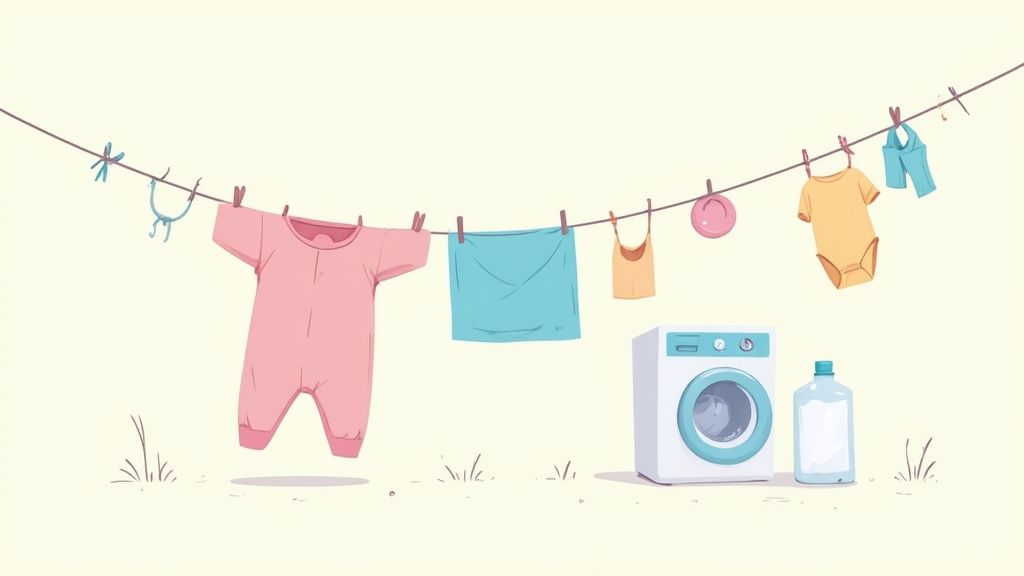
Trying to figure out baby sizing can feel like you’re solving a puzzle where the pieces keep changing. One day, a "3-6 month" outfit is swimming on your little one, and the next, it’s practically a sausage casing. The secret? Stop looking at the age on the tag.
Instead, focus on your baby’s weight and length. These two numbers will always give you a much more reliable idea of how a sleeper is actually going to fit. Think of the age range as more of a ballpark guess than a strict rule. After all, a long, lean baby and a short, stout baby might be the same age, but they'll need completely different sizes to be comfy and safe.
The golden rule for baby clothes is to always check the brand's specific size chart before you buy. A size "6M" from one company can be worlds away from another's. A quick peek at their chart can save you a world of return-shipping headaches.
Checking the brand’s measurements ensures the baby zipper sleeper you pick will have that perfectly snug (but not tight!) fit. To see what I mean, you can check out a detailed size chart with weight and length guidelines to match your little one to their ideal size.
How Fabric Affects the Fit
Beyond the numbers on a chart, the material itself plays a huge part in how a sleeper fits and feels. Different fabrics have different personalities—some stretch, some don't—which affects both comfort and how long you'll get to use it.
Let's look at a couple of popular options:
- Bamboo Viscose: This stuff is known for being incredibly stretchy, which means you get a lot of wiggle room. It snuggles up to your baby's body and often fits longer than other materials simply because it grows right along with them.
- Classic Cotton: Super soft and breathable, but cotton typically has less give. It offers a more structured fit, making it extra important to nail the size right from the get-go.
So, a bamboo sleeper in the right size will give you a forgiving, flexible fit that’s perfect for those sudden growth spurts.
Footed vs. Footless Sleepers
Once you’ve got the size figured out, it's time to choose a style: footed or footless? Honestly, there's no wrong answer here, and most parents I know have a mix of both.
Footed sleepers are the classic for a reason. They’re an all-in-one cozy package, keeping your baby’s toes warm without you having to hunt for those tiny socks that always seem to vanish into thin air. They’re a go-to for chilly nights or for anyone who loves the simplicity of a single outfit.
On the flip side, footless sleepers are a game-changer for fast-growing babies. With no feet to outgrow, your little one can often rock them for weeks, or even months, longer. They're also brilliant for warmer weather or for little movers and shakers who are starting to walk and need their feet free to get a good grip.
Common Questions Parents Ask About Zipper Sleepers
Even after you've done your research, a few questions always seem to pop up. Let's tackle the most common ones we hear from parents, so you can feel totally prepared when picking out the best baby zipper sleepers for your little one.
Are Zipper Sleepers Really Safe for Newborns?
Yes, absolutely—as long as you keep two key things in mind. First, the fit has to be snug. You never want loose, baggy fabric in the crib, as it can be a suffocation risk for a newborn who can't move it away from their face.
Second, look for thoughtful safety details like a "zipper garage." It’s just a little fabric flap that covers the zipper pull at the neckline. This simple feature is a game-changer, preventing the metal from accidentally poking or scratching your baby's delicate chin.
One-Way vs. Two-Way Zippers: What's the Big Deal?
Think of a one-way zipper like a standard jacket zipper—it only zips from the top down. For a diaper change, this means you have to completely unzip and undress your baby, letting all their cozy warmth escape. Not ideal, especially at 3 a.m.
The two-way zipper is the design that parents everywhere rave about. It lets you zip up from the bottom, exposing only what you need to for a diaper change. Your baby's chest and arms stay warm and bundled up, making for a much less disruptive (and chilly) experience for everyone.
So, How Many of These Do I Actually Need?
For a newborn, we’ve found that 6-8 sleepers is the magic number. Between spit-up, drool, and the inevitable diaper blowouts, babies are masters at creating laundry. Having a good stash on hand means you won't be running the washing machine every single day.
It's no surprise that the baby sleepwear market is booming, with projections showing it will reach $53.3 billion by 2030. A big part of that is online shopping, as busy parents love the convenience of getting these essentials delivered right to their door. You can read more about the growth of the baby apparel market here if you're curious.
Ready to find that perfect blend of comfort, safety, and style? Check out the beautiful, faith-inspired bamboo sleepers from Little Venture Co. and wrap your little one in pure softness.
